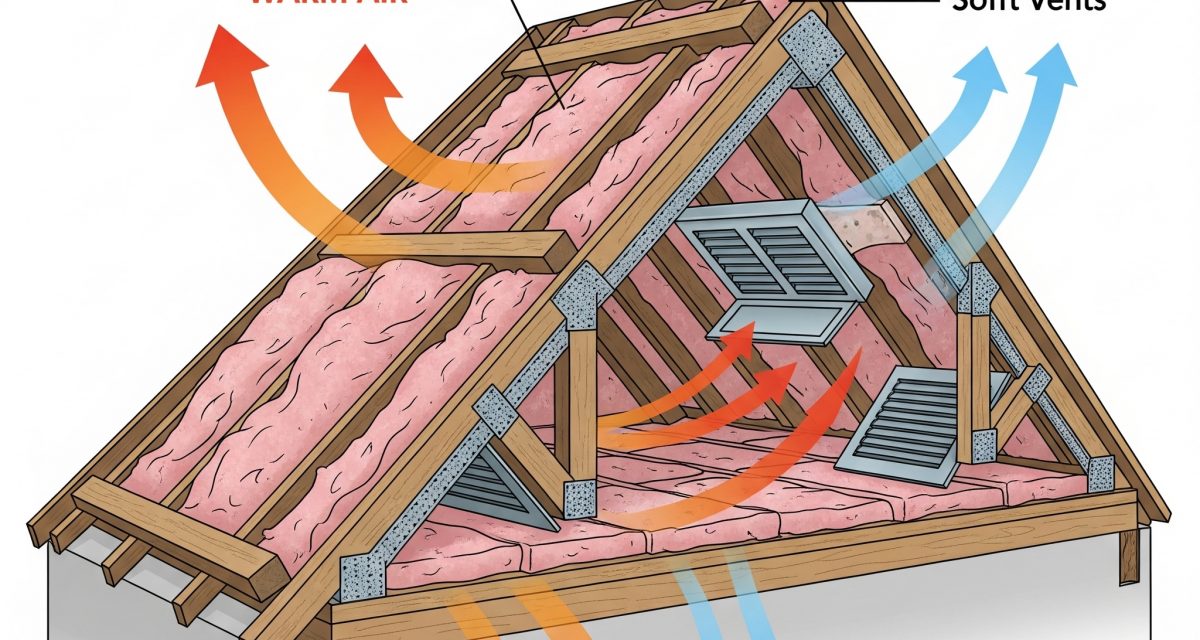Your attic plays a much bigger role in your home’s energy efficiency, comfort, and roof longevity than most homeowners realize. Two of the most important (and misunderstood) components of a healthy attic system are insulation and ventilation.
While they may seem like opposites—one keeps heat in, the other lets air out—they actually work together to regulate your home’s temperature, moisture levels, and energy usage.
At All State Roofing & Chimney, we help homeowners throughout New Jersey design and maintain attic systems that are properly insulated and ventilated—especially important in NJ’s climate, which brings hot, humid summers and cold, snowy winters.
In this post, we’ll break down how attic insulation and ventilation work together, what happens if they’re out of balance, and how to optimize your home for year-round performance.
Need expert attic help? Call (862) 295-7864
Or request a Free Estimate
Why Your Attic Matters in NJ
In a typical New Jersey home, the attic:
-
Acts as a buffer between outdoor temperatures and your living space
-
Supports the structural integrity of your roof
-
Plays a critical role in energy efficiency
-
Can trap heat and moisture if not ventilated or insulated correctly
Neglecting attic performance can lead to ice dams, roof leaks, mold growth, high utility bills, and shortened shingle lifespan.
The Role of Attic Insulation
Attic insulation’s job is to slow the transfer of heat between your home and the outside environment. In NJ:
-
In winter, it keeps heat from escaping your living space into the attic
-
In summer, it blocks attic heat from radiating down into your home
The most common insulation materials include:
-
Fiberglass batts or rolls
-
Blown-in cellulose or fiberglass
-
Spray foam insulation
The effectiveness of insulation is measured in R-value—the higher the R-value, the better it resists heat transfer. New Jersey homes typically benefit from R-38 to R-60 in attic spaces.
The Role of Attic Ventilation
Ventilation allows your attic to breathe. It works by creating a flow of air from intake vents (usually at the soffits) to exhaust vents (like ridge or gable vents).
Proper ventilation:
-
Prevents moisture buildup that leads to mold and rot
-
Reduces attic heat that can damage shingles
-
Helps prevent ice dams in winter
-
Reduces the load on your HVAC system in summer
Without ventilation, your attic becomes a trap for heat and moisture—damaging your roof and raising your energy bills.
How Insulation and Ventilation Work Together
At first glance, it may seem like these two systems would cancel each other out. After all, insulation retains heat, while ventilation releases it. But they actually serve complementary functions:
-
Insulation keeps your home’s conditioned air (heated or cooled) inside
-
Ventilation keeps unwanted heat and moisture from building up in the attic
When both systems are in balance:
-
Your attic remains close to the outdoor temperature
-
Your living space stays comfortable and efficient
-
Your roof stays dry and protected
-
Ice dams are less likely to form in winter
-
Mold and wood rot are kept at bay year-round
What Happens If They’re Out of Balance?
Too Much Insulation, Not Enough Ventilation
-
Attic traps moisture from living areas
-
Risk of mold, mildew, and wood rot
-
Ice dams and shingle damage in winter
-
Decreased roof life expectancy
Too Much Ventilation, Poor Insulation
-
Heat loss in winter (higher heating bills)
-
Hot upstairs rooms in summer
-
HVAC system works harder than necessary
-
Risk of condensation forming on cold surfaces
Both extremes cause energy waste, roof issues, and increased repair costs.
Signs Your NJ Attic Needs Attention
Watch for these red flags:
-
Uneven temperatures between floors
-
High summer cooling or winter heating bills
-
Ice dams on the roof or gutters
-
Condensation or frost inside the attic
-
Mold or musty smells
-
Curling shingles or premature roof aging
If you notice any of these, it’s time to schedule an attic inspection.
Best Practices for NJ Homeowners
1. Seal Air Leaks First
Before adding insulation, seal gaps around light fixtures, chimneys, pipes, and attic hatches. This prevents warm, moist air from reaching the attic.
2. Use Proper R-Value
For most NJ homes, aim for R-49 to R-60 in attic spaces. Blown-in insulation is often the most efficient way to meet this.
3. Ensure Clear Vent Paths
Insulation should not block soffit vents. Use baffles or vent chutes to keep air flowing freely from intake to exhaust.
4. Maintain a Balanced System
Aim for a 1:1 ratio of intake to exhaust ventilation. Most codes recommend 1 sq. ft. of ventilation per 150 sq. ft. of attic space.
5. Schedule Annual Inspections
Your attic needs maintenance, too. Schedule a yearly checkup for insulation levels, airflow, moisture, and pests.
Why It Matters for Your Roof
A poorly ventilated attic can cause:
-
Shingle overheating and curling
-
Ice dams that damage eaves and gutters
-
Trapped moisture that ruins wood decking
-
Shortened roof lifespan by 5–10 years
If you’re investing in roof replacement, make sure your attic is up to standard—or you could be back on the roof sooner than expected.
Why Choose All State Roofing & Chimney?
We don’t just install roofs—we protect homes from the inside out. Our team of experts will:
-
Inspect your attic for insulation and airflow issues
-
Recommend upgrades based on NJ building codes
-
Install baffles, vents, or additional insulation
-
Ensure your roofing and attic work as one efficient system
-
Handle repairs caused by ice dams, leaks, or poor ventilation
Call now: (862) 295-7864
Or schedule your Free Estimate
Final Thoughts
If you’re serious about protecting your roof, lowering your energy bills, and improving your home’s comfort, don’t overlook your attic. The best-performing homes in New Jersey have well-insulated, well-ventilated attics—and the difference is real.
Let the pros at All State Roofing & Chimney help you optimize your home today.
